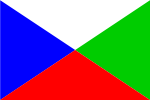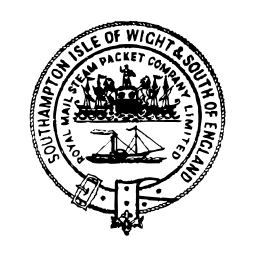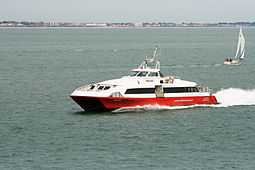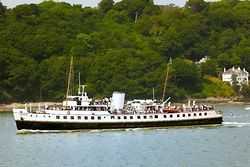Red Funnel
 | |
| Industry | Transport |
|---|---|
| Founded | 1861 |
| Headquarters | Southampton, UK |
Area served | Southampton - Isle of Wight |
| Owner | Infracapital (Asset Management arm of Prudential) |
Number of employees | 500 |
| Parent | Red Funnel Group Ltd. |
| Divisions | Red Funnel Ferries, Red Funnel Distribution, Red Funnel Holidays, Steam Coffee Company, |
| Website | http://www.redfunnel.co.uk/ |
|
Footnotes / references  Red Funnel Company Flag.[1] | |
The Southampton Isle of Wight and South of England Royal Mail Steam Packet Company Limited, which trades as Red Funnel, is a ferry company that carries passengers and vehicles on routes between the English mainland and the Isle of Wight. Vehicle/passenger ferries operate between Southampton and East Cowes, whilst the Red Jet branded high-speed foot passenger service operates between Southampton and Cowes on the west bank of the River Medina. Its head office is in the Red Funnel Travel Centre in Southampton.[2]
Red Funnel's main competitor is Wightlink whose services operate from Portsmouth to Fishbourne and Ryde, and from Lymington to Yarmouth. The other major Solent ferry company, Hovertravel, operates between Southsea and Ryde. Both provide a frequent service to the Isle of Wight, but neither normally serve Southampton, East Cowes or Cowes.
History


The origins of the Red Funnel line date back to 1820, when the Isle of Wight Royal Mail Steam Packet Company was established by Cowes interests to operate the first steamer service from there to Southampton. In 1826, the Isle of Wight Steam Packet Company was formed in Southampton, and by the following year the two companies had started co-ordinating their operations. In 1860, the Southampton, Isle of Wight & Portsmouth Improved Steamboat Company was created to compete with the two established operators, and the threat posed caused the two older companies to merge. They subsequently acquired the assets of the Improved Steamboat Company in 1865.[3]
Formed in 1861, and originally called The Southampton, Isle of Wight and South of England Royal Mail Steam Packet Co. Limited, the merged company's name remains the longest for a registered company in the United Kingdom. The shortened name was adopted after 1935 when all vessels operated by the company adopted the black-topped red funnel in their livery.
The company originally operated a paddle steamer ferry service between Cowes, Isle of Wight and Southampton, England. During its history the company has operated other routes connecting the Isle of Wight and England, together with a sizeable excursion steamer business along the South Coast of England including day trips from the Isle of Wight to France, but today services are concentrated on two routes. In 1931 it introduced its first diesel ferry, the MV Medina. Ferries have steadily increased in size to the current Scottish-built Raptor class operated between East Cowes and Town Quay in Southampton. Between 1969 and the 1990, the company also ran Italian-built hydrofoils between Town Quay and Cowes. This route is now served by high-speed, passenger-only catamarans.
In 1867 Red Funnel instituted a service crossing the River Medina between East and West Cowes. This service was operated by a series of small launches over the years. The service ceased on the outbreak of war in 1939 when the vessels involved were requisitioned by the Admiralty. In 1868 the company took over the Cowes Floating Bridge Company and operated the floating bridge until 1901.[4]
In 1885 the company bought the New Southampton Steam Towing Company and operated tugs and tenders under the subsidiary Red Funnel Towage. In 2002 Red Funnel Towage was sold to AdSteam, later passing to Svitzer Marine.[5]
In 1946 Red Funnel acquired a controlling interest in Cosens & Co Ltd, a rival pleasure steamer operator based in Weymouth. This enabled the combined company to coordinate their excursions and also gave Red Funnel access to the Cosens' marine engineering and ship repair facilities. Excursions came to end in 1966 but the engineering side continued until sold off in 1990 to a management buy-out.[6]
In 2001 the company was sold to JP Morgan Partners Inc. (now CCMP Capital) by Associated British Ports Holdings, which had acquired the company in 1989 as a white knight to fend off a hostile takeover by Sally Lines. In 2004 the company was sold again in a management buy-out backed by the Bank of Scotland for £60 million. On April 12, 2007, the owners of Red Funnel (who include HBOS) announced that they were considering selling Red Funnel.[7] In June of the same year, the company was sold to the Prudential's infrastructure specialist, Infracapital, in a deal valuing the business at more than £200m.
Notable events
The Red Eagle collided with Humber Energy in the Thorne Channel, near Southampton Water, on the evening of Thursday December 21, 2006. [8] Coastguards said nobody was injured and neither vessel was badly damaged. Richard Pellew, of the Maritime and Coastguard Agency, said: "Having examined the minor damage sustained to the Red Eagle we are advising Red Funnel on the repair work the ferry needs before it can resume normal service."
On March 10, 2006 Red Funnel hit the national headlines after one of their car ferries, the Red Falcon, collided with the linkspan at the Southampton Town Quay terminal.[9] Eight passengers and one crew member were injured and significant damage was caused to the Southampton end of the Red Falcon and to the linkspan. The collision caused a 15-foot hole above the waterline and buckling of the car deck doors. The accident occurred 9 years and 1 day after the Red Falcon was in collision with the dredger Volvox Hansa in Southampton Water with limited visibility due to fog.
Current fleet
.jpg)
Vehicle ferries
The following Raptor-class car ferries operate on the Southampton to East Cowes route:
All three vessels were built by Ferguson Shipbuilders of Port Glasgow, and entered service between 1994 and 1996. Between 2003 and 2005 the ferries were refitted and extended both in length and height by the Polish workers of Remontawa in Gdańsk, Poland.[10] This was following a corporate decision driven by Tom Docherty to maximise summer operating capacity taking the previous capacity from around 100 CEUs to 213 CEU
During 2014 MV Red Falcon underwent a 2.2m Refurbishment, which saw the interior and facilities replaced with a bright and new modern look. [11] Due to success and increase of passengers on their services during 2014, it has been confirmed that MV Red Osprey will also receive a 2.2 million refurbishment and should be hoping to enter service in Easter 2015.[12]
Fast passenger service (Red Jet)
The following catamarans operate a high-speed passenger-only service between Cowes and Southampton:[13]
Red Jet 3 was built new for Red Funnel by FBM Marine of Cowes in 1998. She was followed in 2003 by the somewhat larger Red Jet 4, a new building by North West Bay Ships of Tasmania. Red Jet 5, by contrast, was a second-hand acquisition in 2009; she was originally built in 1999 by Pequot River Shipworks of Connecticut to the same FBM design as Red Jet 3.[13] This vessel was previously known as the Bo Hengy, and was operated by Bahamas Ferries until 2008.[14] Red Funnel have drawn up plans for a new 40 metre high speed craft to be built by Incat of Tasmania (likely to be called Red Jet 6), however there is currently no confirmation that the new craft shall be built.
Retired fleet
Classic ferries
Between 1840 and the 1960s, Red Funnel line and its predecessors operated 40 different classic passenger ferries, many of these being paddle steamers. Later ferries sometimes had space allocated for carrying cars but it was not until 1959 that the first purpose-built car ferry was introduced. Classic passenger vessels continued in service until the Balmoral was sold in 1969.[15][16][17][18][19]
Paddle steamers
| Ship | Service | Notes |
|---|---|---|
| PS Gem | 1840–1883 | |
| PS Ruby | 1841–1872 | The first Isle of Wight steamer to be built of iron |
| PS Pearl | 1844–1867 | |
| PS Queen (I) | 1848–1876 | |
| PS Medina (I) | 1852–1882 | |
| PS Emerald | 1857–1871 | |
| PS Saphire | 1860–1873 | |
| PS Lord of the Isles | 1861–1889 | |
| PS Lady of the Lake | 1861–1887 | |
| PS Vectis | 1866–1910 | |
| PS Southampton | 1872–1902 | |
| PS Carisbrooke | 1876–1905 | |
| PS Prince Leopold | 1876–1905 | |
| PS Princess Beatrice | 1880–1930 | |
| PS Princess Helena | 1883–1950 | Sent to Dunkirk in 1940 |
| PS Her Majesty | 1885–1940 | Sunk during an air raid on Southampton |
| PS Princess of Wales | 1888-1888 | Sunk during trials in Scotland before entering service |
| PS Bangor Castle | 1888–1899 | ex Palmerston |
| PS Solent Queen | 1889–1948 | Sent to Dunkirk in 1940 |
| PS Prince of Wales | 1891–1937 | |
| PS Lorna Doone | 1891–1947 | |
| PS Duchess of York | 1896–1949 | HM Minesweeper 0102 1916-1922. Renamed Duchess of Cornwall in 1928 |
| PS Balmoral (I) | 1900–1947 | |
| PS Queen (II) | 1902–1938 | Renamed Mauretania in 1936 then renamed Corfe Castle in 1938 |
| PS Princess Royal | 1906-1906 | Not accepted after trials and sold. Renamed Emperor of India |
| PS Stirling Castle | 1907–1916 | Sunk off Malta on war service |
| PS Bournemouth Queen | 1908–1957 | |
| PS Lord Elgin | 1908–1955 | |
| PS Princess Mary | 1911–1919 | Sank in the Mediterranean after colliding with the sunken wreck of HMS Majestic |
| PS Princess Elizabeth | 1927–1959 | Now moored at Dunkirk as a conference centre |
| PS Gracie Fields | 1936–1940 | As HMS Gracie Fields she was sunk at Dunkirk |
| PS Lorna Doone (II) | 1949–1952 | Ex Queen of Kent ex HMS Atherstone |
| PS Solent Queen (II) | 1949–1951 | Ex Queen of Thanet ex HMS Melton |
Twin-screw steamers

| Ship | Service | Notes |
|---|---|---|
| TSS Upton | 1946–1950 | Purchased from Birkenhead Corporation |
| TSS Robina | 1948–1949 | Purchased from Coast Lines Ltd |
Motor vessels
| Ship | Service | Notes |
|---|---|---|
| MV Medina (III) | 1931–1962 | The first diesel engined ferry on the Solent |
| MV Vecta (I) | 1938–1965 | Sold to P&A Campbell, renamed Westward Ho |
| MV Norris Castle (II) | 1947–1962 | Ex LCT 828 |
| MV Balmoral (II) | 1949–1969 | Now owned by Waverley Steam Navigation Co. Ltd and still in service |
Car ferries

Although some earlier ferries provided space for cars, the first car ferry purpose built for Red Funnel was introduced in 1959. Besides the Raptor class vessels that are still in service, the following purpose built car ferries have been used by Red Funnel:[19][20][21]
| Ship | Service | Notes |
|---|---|---|
| MV Carisbrooke Castle | 1959–1974 | Sold to Italy and renamed Citta di Meta. Scrapped 2007[6] |
| MV Osborne Castle | 1962–1978 | Sold to Canada and renamed Le Gobelet d'Argent, then Le Maxim, then Cavalier Maxim[6] |
| MV Cowes Castle | 1965–1994 | Sold to Croatia and renamed Nehaj. Scrapped 2008[6] |
| MV Norris Castle (III) | 1968–1994 | Sold to Croatia and renamed Lovrjenac. Scrapped 2008[6] |
| MV Netley Castle | 1974–1997 | Sold to Croatia and renamed Sis[6] |
| MV Bergen Castle | 2003–2005 | Ex Nordhordland, purchased to maintain a three boat service during refit period of current fleet. Sold and renamed Stella[6] |
Fast passenger ferries
The first fast ferry introduced by Red Funnel was the Sea Coach Island Enterprise, a motor cruiser capable of carrying 11 passengers at 20 knots. She was built by the British Power Boat Company in Hythe, and operated from 1933 to 1938.[19]
Hovercraft
In 1968 the company ran trials with an HM2 sidewall hovercraft, number 002, in order to compete with the Seaspeed service which used an SRN6 between Southampton and Cowes. Due to the unreliability of the craft it never entered passenger service. In 1981 Red Funnel acquired a pair of HM2 MkIIIs, GH2019 & GH2024, which were primarily used on the charter service for Vosper Thorneycroft transporting workers from the Isle of Wight to the Woolston yard and back each day. These two craft were disposed of in June 1982 and the charter subsequently operated by the augmented hydrofoil fleet.[4]
Hydrofoils
The first hydrofoils to operate on the Southampton to Cowes route, and the first in commercial service in the United Kingdom, were the Italian designed Shearwater and Shearwater I. These were introduced by Red Funnel in 1969, and each seated 54 passengers. They were replaced in 1973 by two 67 seat RH70 hydrofoils built by Cantière Navale Rodriguez and named Shearwater 3 and Shearwater 4. The latter was delivered some 5 months after the former and in the interim a PT20 craft, Fleccia di Reggio was chartered to stand in. In 1982 Shearwater 5 and Shearwater 6 were added. In 1991, with the introduction of the first Red Jet catamarans, the hydrofoils were demoted to back-up duties until they were finally withdrawn in 1998.[22]
Red Jets
The first of the Red Jet series of fast passenger catamarans were introduced in 1990. Red Jet 1 and Red Jet 2 were designed and built by FBM Marine of Cowes, and seated 138 passengers. They were sold to Caspian Mainport in May 2009 for continued service in the Caspian Sea, and left the Solent for Saint Petersburg on 15 May 2009.[21][22][23]
Tugs and tug tenders
Some tugs also had passenger accommodation to enable them to serve as tenders to liners not actually berthing in Southampton and to augment the excursion fleet on occasion.[4]

| Ship | Service | Notes |
|---|---|---|
| ST Sovereign | 1885–1894 | |
| ST Alexandra | 1885–1897 | |
| ST Fawn | 1885–1897 | |
| TSS T/T Albert Edward | 1886–1934 | |
| TSST Hercules | 1890–1927 | |
| TSST Vulcan | 1893–1957 | |
| TSST Ajax | 1894–1936 | |
| TSST Neptune (I) | 1896–1904 | |
| TSST Hector | 1903–1958 | |
| TSST Neptune (II) | 1910–1961 | |
| TSST Sir Bevois (I) | 1916–1941 | Sunk during an air raid in Plymouth |
| ST Minas | 1920–1931 | |
| ST Ascupart | 1922–1927 | |
| ST Morglay | 1922–1927 | |
| TSST Canute | 1923–1965 | |
| TSST Clausentum | 1926–1966 | |
| TSS T/T Calshot (I) | 1930–1964 | Renamed Galway Bay. Now preserved at Southampton as Calshot |
| ST Empire Lilliput | 1944–1947 | Managed for Ministry of War Transport |
| ST TID 69 | 1944–1947 | Managed for Ministry of War Transport |
| ST Bantam | 1946–1958 | |
| TSS T/T Paladin | 1946–1960 | |
| ST Beamish | 1951–1952 | Ex Queensgarth, ex Empire Paul. Later renamed Thunder Cape |
| TSST Hamtun (I) | 1953–1970 | |
| TSST Sir Bevois (II) | 1953–1968 | |
| TSMT Atherfield | 1956–1971 | |
| TSMT Culver | 1956–1983 | |
| TSMT Dunnose | 1958–1980 | |
| TSM T/T Gatcombe (I) | 1960–1969 | |
| TSMT Thorness | 1961–1983 | |
| TSM T/T Calshot (II) | 1964–1985 | |
| MT Bonchurch | 1966–1983 | Ex Baie Comeau, ex Abeille No 13, ex TID 174 |
| TSMT Chale | 1965–1986 | |
| MT Gatcombe (II) | 1970–1997 | Sold and renamed Multratug 6 |
| MT Vecta (II) | 1970–1999 | Sold and renamed Multratug 8, renamed Serwal 4 |
| TSMT Clausentum (II) | 1980–1993 | Sold and renamed Strathfoyle, renamed Westlund |
| TSMT Gurnard | 1982–1985 | Ex Aziebank. ex Azie |
| TSMT Totland | 1982–1985 | Ex Europabank, ex Europa |
| TSMT Hamtun (II) | 1985–2002 | Renamed Multratug 16 |
| TSMT Sir Bevois (III) | 1985–2002 | Renamed Svitzer Bevois |
| TSMT Portunus | 1985-1993 | Ex John af Goteborg, resumed name of John af Goteborg, renamed John |
| TSMT Redbridge | 1995–2002 | Renamed Adsteam Redbridge, renamed Svitzer Redbridge |
Medina crossing
| Ship | Service | Notes |
|---|---|---|
| SL Precursor (I) | 1867–1883 | |
| SL Princess Louise | 1871–1944 | Sunk in collision with a landing craft off Town Quay shortly before D-Day |
| SL Medina (II) | 1884–1931 | |
| SL Precursor (II) | 1898–1939 | Requisitioned by the Admiralty for service in the Mediterranean |
| ML Norris Castle (I) | 1938–1939 | Requisitioned by the Admiralty for service in the Mediterranean |
Onboard facilities
Red Funnel Ferries offer hot and cold food, fresh coffee and cakes, a bar, and were the first on the Solent to offer a free Wi-Fi service.
References
- ↑ 1.0 1.1 Red Funnel. "Red Funnel Company History". Retrieved 23 August 2010.
- ↑ "Red Funnel Corporate Information." Red Funnel. Retrieved on 19 October 2010. "Red Funnel Travel Centre: 12 Bugle Street, Southampton, SO14 2JY, UK."
- ↑ "Timeline". Red Funnel. Retrieved 2010-04-20.
- ↑ 4.0 4.1 4.2 Adams, RB (1986). Red Funnel and Before. Southampton: Kingfisher Publications. ISBN 0-946184-21-6.
- ↑ "Chronology | Red Funnel Isle of Wight Ferries". Redfunnel.co.uk. Retrieved 2012-04-19.
- ↑ 6.0 6.1 6.2 6.3 6.4 6.5 6.6 Adams, Keith (2010). Red Funnel 150. Isle of Man: Richard Danielson. ISBN 978-0-9513155-5-2.
- ↑ "Island ferry company may be sold". BBC. 2007-04-12. Retrieved 2010-04-20.
- ↑ Ferry and barge channel collision, 'BBC.co.uk'
- ↑ "Investigators examine ferry crash". BBC. 2006-03-11. Retrieved 2010-04-20.
- ↑ "Red Funnel - Vehicle ferry fleet". www.redfunnel.co.uk. Retrieved 2008-12-25.
- ↑ http://www.redfunnel.co.uk/newlook
- ↑ http://www.redfunnel.co.uk/corporate-information/media-and-pr/2014-news-releases/green-light-given-to-red-osprey-refurbishment/
- ↑ 13.0 13.1 "Red Jet Hi-Speed Fleet". Red Funnel. Retrieved 2010-04-20.
- ↑ Keith Adams [2010], Red Funnel 150; Richard Danielson, ISBN 978-0-9513155-5-2
- ↑ "Vessel Archive 1840-1860". Red Funnel. Retrieved 2010-04-20.
- ↑ "Vessel Archive 1861-1880". Red Funnel. Retrieved 2010-04-20.
- ↑ "Vessel Archive 1881-1900". Red Funnel. Retrieved 2010-04-20.
- ↑ "Vessel Archive 1901-1920". Red Funnel. Retrieved 2010-04-20.
- ↑ 19.0 19.1 19.2 "Vessel Archive 1921-1950". Red Funnel. Retrieved 2010-04-20.
- ↑ "Vessel Archive 1951-1980". Red Funnel. Retrieved 2010-04-20.
- ↑ 21.0 21.1 "Vessel Archive 1981-2010". Red Funnel. Retrieved 2010-04-20.
- ↑ 22.0 22.1 "News Release 21-07-2009". Red Funnel. 2009-07-21. Retrieved 2010-04-20.
- ↑ "Red Jets sail into sunset". Isle of Wight County Press. 2009-05-15. Retrieved 2009-05-16.
External links
| Wikimedia Commons has media related to Red Funnel. |
- Redfunnel.co.uk
- Red Funnel companies grouped at OpenCorporates
| ||||||||||||||